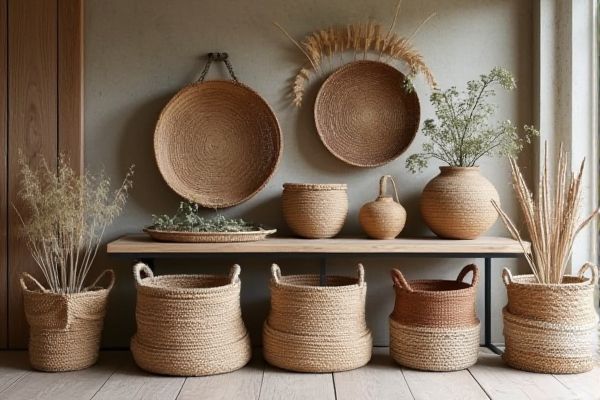
Sustainable basket storage offers eco-friendly, biodegradable materials that reduce environmental impact compared to synthetic storage solutions often made from non-recyclable plastics. Explore the article to discover which storage option best suits your lifestyle and sustainability goals.
Table of Comparison
| Feature | Sustainable Basket Storage | Synthetic Storage |
|---|---|---|
| Material | Natural fibers (bamboo, rattan, seagrass) | Plastic, resin, synthetic fabrics |
| Environmental Impact | Biodegradable, low carbon footprint | Non-biodegradable, higher carbon footprint |
| Durability | Moderate, depends on fiber quality | High resistance to moisture and wear |
| Maintenance | Requires gentle cleaning, air drying | Easy cleaning with water and detergent |
| Aesthetic Appeal | Natural, rustic look | Modern, uniform appearance |
| Cost | Generally affordable, handmade options may be pricier | Varies, often cheaper mass-produced |
| Use Cases | Eco-friendly storage, decorative purposes | Heavy-duty storage, outdoor resistant |
Introduction to Basket Storage Solutions
Basket storage solutions crafted from natural materials such as wicker, rattan, and bamboo offer eco-friendly alternatives to synthetic storage options, ensuring biodegradability and reduced environmental impact. These sustainable baskets provide durability and aesthetic appeal while minimizing plastic waste compared to synthetic storage bins made from polypropylene or polyethylene. Emphasizing renewable resources and craftsmanship, sustainable basket storage contributes to responsible consumption and sustainable home organization practices.
Defining Sustainable Basket Storage
Sustainable basket storage refers to organizing solutions made from renewable, biodegradable materials like wicker, rattan, seagrass, or bamboo, designed to minimize environmental impact. These natural fibers offer breathability and durability while supporting eco-friendly harvesting and manufacturing practices. In contrast to synthetic storage options, sustainable baskets reduce reliance on plastics, lower carbon footprints, and promote circular economy principles.
Understanding Synthetic Basket Storage
Synthetic basket storage offers durability and resistance to moisture, making it an efficient choice for protecting your belongings in various environments. Unlike sustainable baskets made from natural fibers like rattan or seagrass, synthetic variants utilize materials such as polypropylene or resin that provide long-lasting performance without the risk of mold or insect damage. Choosing synthetic basket storage enhances practicality while maintaining a lightweight design ideal for modern organization needs.
Material Sourcing and Environmental Impact
Sustainable basket storage typically uses natural materials like rattan, bamboo, or seagrass, sourced from renewable or responsibly managed environments that promote biodiversity and soil health. Synthetic storage options often rely on petroleum-based plastics, which contribute to fossil fuel depletion and generate microplastic pollution during production and disposal. The environmental impact of sustainable baskets is lower due to biodegradability and reduced carbon footprint compared to synthetic alternatives that persist in ecosystems and require energy-intensive manufacturing processes.
Durability and Lifespan Comparison
Sustainable basket storage, typically crafted from natural materials like wicker or bamboo, offers excellent durability with resistance to wear and a natural ability to breathe, prolonging the lifespan of stored items. Synthetic storage solutions, often made from plastic or resin, provide high durability against moisture and pests but may degrade faster under UV exposure and can become brittle over time. You can expect sustainable baskets to maintain their integrity longer in dry, indoor environments, while synthetic options excel in moisture-prone settings but may require replacement more frequently.
Aesthetic Appeal and Design Flexibility
Sustainable basket storage offers natural textures and organic patterns, enhancing aesthetic appeal with warmth and authenticity in various interior styles. Its design flexibility stems from handcrafted techniques and renewable materials, allowing customization in shapes, sizes, and finishes to complement eco-conscious decor. Synthetic storage, while available in diverse colors and forms, often lacks the tactile richness and timeless charm provided by sustainable baskets, limiting its visual integration in environmentally focused designs.
Health and Safety Considerations
Sustainable basket storage, made from natural fibers like bamboo or wicker, offers superior breathability and reduces the risk of chemical exposure compared to synthetic storage options composed of plastics or polymers. Natural materials minimize the release of harmful volatile organic compounds (VOCs), promoting a healthier indoor environment for Your family. Choosing sustainable basket storage also means fewer fire hazards and less toxic residue in case of accidents, enhancing overall safety.
Cost Analysis: Sustainable vs Synthetic
Sustainable basket storage typically involves higher initial costs due to natural materials like bamboo or rattan but offers long-term savings through durability and biodegradability. Synthetic storage options are often cheaper upfront but may incur replacement costs and environmental disposal fees over time. Your choice impacts both budget and ecological footprint, making sustainable baskets a cost-effective investment for eco-conscious consumers.
Environmental Footprint and Recycling Potential
Sustainable basket storage, typically made from natural materials like bamboo or wicker, has a significantly lower environmental footprint due to renewable sourcing and biodegradable properties, reducing landfill waste. Synthetic storage options, often composed of plastics, contribute to higher carbon emissions and pose recycling challenges due to mixed polymer compositions and degradation difficulties. Choosing sustainable baskets enhances your environmental responsibility by promoting easier recycling and minimizing long-term pollution.
Choosing the Right Storage for Your Needs
Sustainable basket storage offers eco-friendly materials like rattan and seagrass, providing durability and natural breathability ideal for organizing household items while reducing environmental impact. Synthetic storage, made from plastics and polymers, excels in moisture resistance and structural strength, making it suitable for areas prone to humidity or heavy usage. Selecting storage depends on priorities: sustainability and aesthetics favor natural baskets, while high durability and water resistance align with synthetic options.
 homyna.com
homyna.com